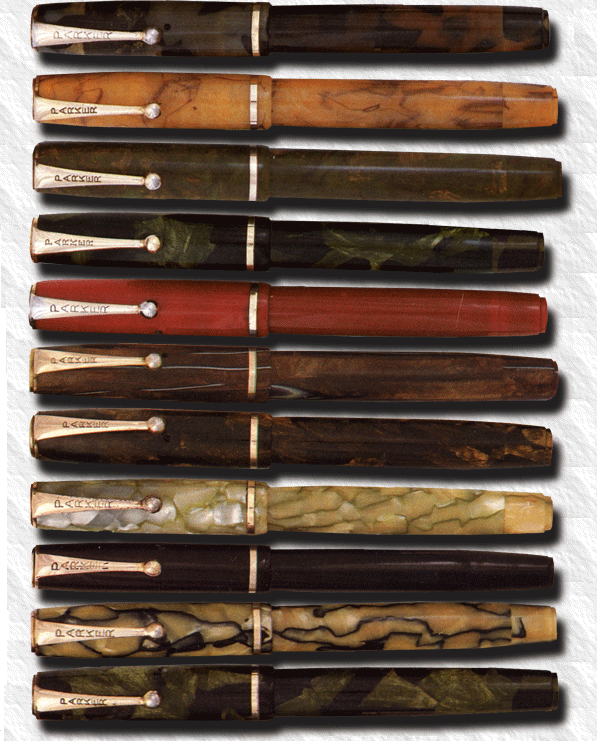
| parkerpens.net |
| PARKERCOLLECTOR.COM |
 Aka Thriftime pens and Depression pens 1932-1934 |
||
The Great Depression cut sales for all pen makers dramatically. In 1929 Parker made a profit of an incredible $5 million and by 1932 sales were down to under $1.2. |
|
|
 |
A selection of colours for the Duette Jr (small with metal clip screw). |
years of dearth (even if it was more like five years), were well equipped to face the times. They decided not to compromise the company and hurting the brand by selling expensive pens cheap. Parker had spent years building the brand, especially the flagship Duofold, persuading people to buy them at $10, when other similiar quality pens went for $5. All this would go down the drain if they were to sell them for a fourth of the price. Furthermore there would be a distinct risk that faithful customers — who indeed had paid $10 for a Duofold — would be a tad irritated if their neighbors were able to buy it for $3. |
|
 |
A selection of colours for the Duette Jr (small with metal clip screw). |
|
able to write. The Duette had a very flat, gold filled brass clip screw and a Duofold style ball ended clip. It sported a single, narrow, gold filled cap band, had a black section, a blind cap the colour of the pen and was a button filler. The nib was marked "Parker fountain pen". There are also examples of ring-top Duettes with a metal "cap" that covers and overlaps the end.
The second series, Duette Jr: |
|
A ring top Depression pen from around 1934 stepped clip screw, |
Duette Sr: Duette Jr: |
|
|
with stepped clip screws, a feature adopted by the Parkette, there are rounded pens, very similiar to the Canadian Televisor but where Televisor had a black clip screw and blind cap this was in the colour of the body. There are even strange stepped clip screws with ring tops. Most of these pens came in marbled designs later adopted by the Parkettes and Challengers to come. The Moderne was revived in Canada in the late 1930's to clean out old stock. It was in every way, save the body imprint, identical to the late style Challenger. The Parker Parco, introduced in late 1932 actually eventually became the Parkette since the first year Parkette was identical to the Parco with the exception of the clip. The clip was a three step chevron similar to the Parkette, with the exception of the step above the chevrons.
|
© 1995-2019 Tony Fischier and The Parker Pen Company®/Sanford Ecriture.
This page is in no way sponsored by or created by the Parker Pen Company®. All opinions, views, and thoughts expressed herein are expressly the authors, and in no way reflect the opinions, views, or thoughts of the Parker Pen Company®/Sanford Ecriture. All logos and/or images on these pages are © Copyright of Parker Pen Company®Sanford Ecritureunless otherwise stated and is reprinted by kind permission. If You feel that Your copyright has been violated please contact the WEBMASTER.
Everything on this website is copyrighted by law and can not be used without written permission from the author, Tony Fischier. You may however use the information as reference material and although it is forbidden to make digital copies or reproductions it may be physically printed for personal use, which does not include use on other web pages or in advertising. You may however quote parts of the content of this website, digitally or physically, providing that the source and author is clearly stated, together with the copyright information. In the US referred to as Fair use. If you use any information on this site, add a link.
Feel free to donate a small sum through Paypal to help this site to stay online. Acknowledgements.
Parkercollector.com in translated versions
